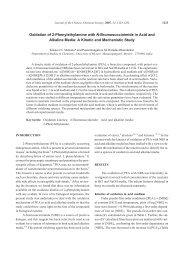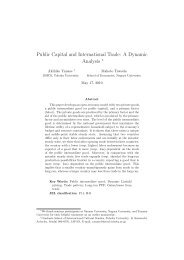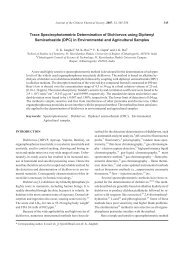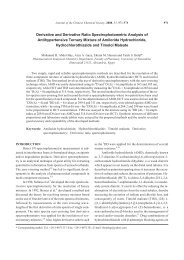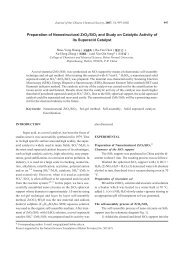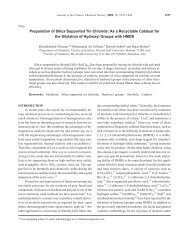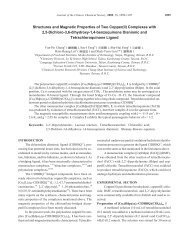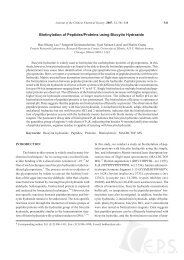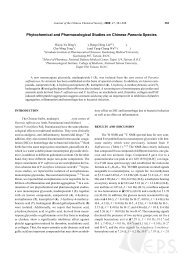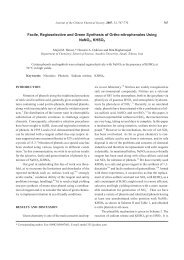Catalytic Reaction of Para-Isopropylbenzaldehyde with ...
Catalytic Reaction of Para-Isopropylbenzaldehyde with ...
Catalytic Reaction of Para-Isopropylbenzaldehyde with ...
Create successful ePaper yourself
Turn your PDF publications into a flip-book with our unique Google optimized e-Paper software.
<strong>Catalytic</strong> <strong>Reaction</strong> <strong>of</strong> <strong>Para</strong>-<strong>Isopropylbenzaldehyde</strong> <strong>with</strong> Propionaldehyde<br />
over Solid Base Catalysts<br />
Shin Yi Shiau ( ) and An-Nan Ko* ( )<br />
Department <strong>of</strong> Chemistry, Tunghai University, Taichung, Taiwan, R.O.C.<br />
3-(4-Isopropyl-phenyl)-2-methyl-acrylaldehyde (4IP2MA) was synthesized from propionaldehyde<br />
(PA) and para-isopropylbenzaldehyde (IPB) via cross aldol condensation over alkaline earth metal oxides<br />
or Al2O3-MgO mixed oxides (AM) at 120-190 C by using a batch reactor. The catalytic activity is enhanced<br />
<strong>with</strong> the base amounts <strong>of</strong> both alkaline earth metal oxides and the mixed oxides. The reaction system<br />
is free <strong>of</strong> diffusional limitation at a stirring speed larger than 600 rpm. Increasing the catalyst weight,<br />
reaction temperature, reaction time and IPB/PA mol ratio enhances the PA conversion, whereas the<br />
4IP2MA selectivity remains small change except for IPB/PA ratio. Favorable results occur on the PA conversion<br />
and the 4IP2MA selectivity for the reaction in nonpolar solvents <strong>of</strong> cyclohexane and benzene.<br />
Reused catalysts <strong>of</strong> MgO and AM exhibit no catalyst decay. For the formation <strong>of</strong> 4IP2MA, the reaction<br />
mechanism is proposed and the apparent activation energy is calculated.<br />
Keywords: 3-(4-Isopropyl-phenyl)-2-methyl-acryaldehyde; Hydrotalcite; Alkaline earth metal oxide;<br />
<strong>Para</strong>-<strong>Isopropylbenzaldehyde</strong>; Propionaldehyde.<br />
INTRODUCTION<br />
Although extensive studies have focused on heterogeneous<br />
acid catalysis, the application <strong>of</strong> base catalysts has<br />
received much less attention. However, an increasing interest<br />
in this field has become important during the past two<br />
decades. Many types <strong>of</strong> reactions are base-catalyzed, viz.<br />
alkylation, dehydrogenation, hydrogenation, isomerization,<br />
and aldol condensation. 1-4 Aldol condensation may<br />
occur via self-condensation between two <strong>of</strong> the same aldehyde<br />
or ketone molecules or via cross-condensation between<br />
two molecules <strong>of</strong> different aldehydes or ketones. 5-11<br />
-Pentyl cinnamaldehyde was synthesized from benzaldehyde<br />
and n-heptaldehyde using solid base catalysts such as<br />
anionic exchange resins, 12 solid-liquid phase transfer catalysts,<br />
13 organic-inorganic hybride catalysts and MCM-41<br />
supported metal oxides. 14,15 With the MCM-41 material<br />
containing strong hindered amine base, catalyst decay occurred<br />
due to loss <strong>of</strong> the base at higher reaction temperatures<br />
and poisoning <strong>of</strong> strong basic sites. For this reaction<br />
over magnesium oxide supported on Al-MCM-41, increasing<br />
the deposited amount <strong>of</strong> MgO on Al-MCM-41 enhances<br />
the catalyst base amount but decreases the surface area.<br />
Journal <strong>of</strong> the Chinese Chemical Society, 2006, 53, 1539-1545 1539<br />
Dedicated to the memory <strong>of</strong> the late Pr<strong>of</strong>essor Ho Tong-Ing.<br />
* Corresponding author. Fax: +886-4-23590426; E-mail: anko@thu.edu.tw<br />
The catalytic activity <strong>of</strong> Al-MCM-41 is greatly enhanced<br />
by the deposition <strong>of</strong> MgO. 15<br />
Hydrotalcite-like compounds, being the precursors<br />
for mixed oxides have recently drawn much attention due<br />
to their potential applications in the field <strong>of</strong> adsorbants, anion<br />
exchangers and catalysts. Hydrotalcites are layered<br />
II III X<br />
double hydroxides <strong>of</strong> the general formula[ M1XMX( OH)<br />
2]<br />
[AX/n] n- where M II and M III are di- and trivalent cations, respectively,<br />
in the octahedral positions <strong>with</strong>in the hydroxide<br />
layers, and A n is the anion. 16 Hydrotalcites and their derived<br />
mixed metal oxides exhibit characteristic structure<br />
and surface properties. Accordingly, they have been used in<br />
catalytic reactions such as dehydration, alkylation and<br />
aldol condensation. 17-22<br />
Cyclamen aldehyde is a raw material for the manufacture<br />
<strong>of</strong> perfumes, flavors and fine chemicals. 23 This<br />
compound is produced by hydrogenation <strong>of</strong> 3-(4-isopropyl-phenyl)-2-methyl-acryaldehyde<br />
(4IP2MA) and is traditionally<br />
made from propionaldehyde (PA) and para-isopropylbenzaldehyde<br />
(IPB) in the liquid phase by using sodium<br />
or potassium hydroxide as catalysts. However, such a<br />
process suffers from separation procedures, corrosion hazards,<br />
and environmental problems due to the use <strong>of</strong> alkali
1540 J. Chin. Chem. Soc., Vol. 53, No. 6, 2006 Shiau and Ko<br />
metal hydroxide. In this study, solid bases such as alkaline<br />
earth metal oxides and Al2O3-MgO mixed oxides were utilized<br />
as catalysts for this synthetic reaction. The effects <strong>of</strong><br />
various factors, viz. the stirring speed, the solvent, catalyst<br />
weight, catalyst type, para-isopropylbenzaldehyde/propionaldehyde<br />
molar ratio (IPB/PA), reaction temperature,<br />
and reaction time on the catalytic results were investigated.<br />
In addition, the catalytic results were correlated to the catalyst<br />
properties. The reaction mechanism and the activation<br />
energy for the formation <strong>of</strong> 4IP2MA was proposed and calculated.<br />
EXPERIMENTAL SECTION<br />
Catalyst Preparation<br />
Both samples <strong>of</strong> MgO (Strem, 99.95%) and CaO<br />
(R.D.H., 96%) were calcined at 600 C for 6 h prior to the<br />
catalytic reactions. SrO and BaO were prepared, respectively,<br />
from SrCO3 (AJX, 96%) and BaCO3 (R.D.H., 99%)<br />
via calcinations at 900 C for6h.Al2O3-MgO mixed oxides<br />
AMXY <strong>with</strong> Al to Mg molar ratio X:Y were prepared<br />
by co-precipitation <strong>of</strong> two mixtures <strong>of</strong> aqueous solutions.<br />
24,25 To prepare AM21, as an example, 64.0 g<br />
Al(NO)39H2O (R.D.H., 99%) and 21.8 g Mg(NO3)26H2O<br />
(R.D.H., 99%) were dissolved in 500 mL de-ionized water<br />
to form solution A. Solution B was prepared by dissolving<br />
40.0 g NaOH and 21.2 g Na2CO3 in 500 mL de-ionized water.<br />
Solutions A and B were added dropwise into a beaker<br />
containing 300 mL de-ionized water. The pH value <strong>of</strong> the<br />
resulting solution was 9~10. The solution was kept at 60 C<br />
for 18 h and then was filtered. The precipitate was purified,<br />
dried and calcined at 450 Cfor8h.<br />
Catalyst Characterization<br />
The powder X-ray diffraction patterns <strong>of</strong> various catalysts<br />
were measured <strong>with</strong> an X-ray diffractometer using<br />
CuK radiation in the angle range 2 =2~80 (Shimadzu<br />
XD-5). The BET surface areas <strong>of</strong> various samples were determined<br />
<strong>with</strong> a gas sorption analyzer (Quantachrome<br />
Quantasorb). The catalyst basicity was obtained by temperature-programmed<br />
desorption <strong>of</strong> carbon dioxide. 26 Prior to<br />
adsorption <strong>of</strong> carbon dioxide, 0.1 g <strong>of</strong> catalyst was heated<br />
under helium flow (40 mL/min) <strong>with</strong> a rate <strong>of</strong> 10 C /min<br />
from 110 to 500 C to remove water from the sample and<br />
then cooled to room temperature. Measured pulses <strong>of</strong> carbon<br />
dioxide (pulse volume, 0.5 mL) were injected into he-<br />
lium gas and carried through the catalyst sample until saturated<br />
adsorption. Then the temperature was increased to<br />
110 C and kept there for 2 h to remove the physisorbed<br />
carbon dioxide. Finally the system was heated from 110 to<br />
500 C at10C per minute and kept at 500 C for 30 min.<br />
The TPD diagrams were obtained by monitoring the desorbed<br />
gas <strong>with</strong> a thermal conductivity detector at 100 C<br />
and an electric current 160 mA. The base amounts were obtained<br />
from the peak areas <strong>of</strong> various samples using a given<br />
amount <strong>of</strong> CO2 as the calibration standard.<br />
<strong>Catalytic</strong> <strong>Reaction</strong><br />
The catalyst (0.1~0.3 g) was added into a mixture <strong>of</strong><br />
PA (0.015~0.183 mol; Aldrich, 98%) and IPB (0.012~<br />
0.092 mol; Aldrich, 98%). The solvents (35 mL) were benzene,<br />
cyclohexane, tetrahydr<strong>of</strong>uran, and ethyl acetate. All<br />
solvents were obtained from commercial sources <strong>with</strong> high<br />
purity. The reaction was carried out at 120-190 C for a period<br />
<strong>of</strong> 4hinastirred batch autoclave reactor (100 mL<br />
EZE-Seal, Autoclave Engineering, Inc.). The reaction<br />
products were collected periodically. Then they were identified<br />
<strong>with</strong> a GC-MS (Hitachi M-52) and analyzed by a GC<br />
(HP 5890 series II) using a flame-ionization detector and a<br />
50 m × 0.2 mm PONA capillary column (Supelco).<br />
RESULTS AND DISCUSSION<br />
Fig. 1 shows the powder XRD spectra <strong>of</strong> various alkaline<br />
earth metal oxides. The diffraction patterns reveal<br />
characteristic structures <strong>of</strong> MgO, CaO, SrO and BaO. According<br />
to our previous report, 25 the powder XRD spectra<br />
<strong>of</strong> various AMXY mixed oxides are consistent <strong>with</strong> other<br />
studies. 21,27 The spectrum <strong>of</strong> AM15 exhibits a structure<br />
similar to that <strong>of</strong> MgO. As the Al/Mg mol ratio increased<br />
from 1/5 to 1/2, the peaks characteristic <strong>of</strong> calcined hydrotalcites<br />
appear at 2 =43 and 62. In addition, the peak intensities<br />
are enhanced remarkably, indicating much better<br />
crystallinity <strong>of</strong> AM12. Continuous increase <strong>of</strong> the Al/Mg<br />
mol ratio results in the decrease <strong>of</strong> crystallinity as well as<br />
the appearance <strong>of</strong> Al2O3 structure (2 =37, 45 and 66).<br />
The crystal structures <strong>of</strong> AM61 and AM15 resemble those<br />
<strong>of</strong> Al2O3 and MgO, respectively. Fig. 2 shows the temperature-programmed<br />
desorption <strong>of</strong> carbon dioxide from various<br />
AMXY samples. The base amount increases <strong>with</strong> the<br />
mol ratio <strong>of</strong> Mg to Al.<br />
Table 1 lists the physical properties and catalytic re-
Aldolization over Solid Base Catalysts J. Chin. Chem. Soc., Vol. 53, No. 6, 2006 1541<br />
sults <strong>of</strong> various samples. The surface area <strong>of</strong> Al2O3 is apparently<br />
larger than that <strong>of</strong> MgO. Consequently, AM61 and<br />
AM15 exhibit, respectively, the largest and the smallest<br />
surface areas among the AM samples. The base amount <strong>of</strong><br />
Fig. 1. Powder XRD patterns <strong>of</strong> alkaline earth metal<br />
oxides. (a) MgO; (b) CaO; (c) SrO; (d) BaO.<br />
Fig. 2. TPD <strong>of</strong> CO2 from various AMXY samples. XY:<br />
(a) 15; (b) 12; (c) 21; (d) 31; (e) 61.<br />
AMXY catalysts increases <strong>with</strong> decreasing the Al2O3/MgO<br />
mol ratio. For alkaline earth metal oxides, the surface areas<br />
follow the order <strong>of</strong> MgO CaO SrO BaO. The base<br />
amount was reported to show a similar trend, whereas the<br />
basic strength exhibited the reverse order. 28<br />
In the reaction <strong>of</strong> IPB <strong>with</strong> PA, the products include<br />
4IP2MA and 2-methyl-2-pentenal (2M2P). The chemical<br />
equations are shown as follows:<br />
The conversion, product selectivity and product yield are<br />
defined according to the mol <strong>of</strong> PA converted. Therefore i<br />
is 1 for 4IP2MA and 2 for 2M2P.<br />
mol <strong>of</strong> PA converted<br />
Conversion X (mol %) = 100%<br />
mol <strong>of</strong> PA in the feed<br />
i × mol <strong>of</strong> product j<br />
Selectivity Sj <strong>of</strong> product j (mol %) = 100%<br />
mol <strong>of</strong> PA converted<br />
i × mol <strong>of</strong> product j<br />
Yield Yj <strong>of</strong> product j (mol %) = 100%<br />
mol <strong>of</strong> PA in the feed<br />
The reaction system was shown to be free <strong>of</strong> diffusional<br />
limitation at a stirring speed larger than 600 rpm. Accordingly,<br />
the following experiments were performed at 700<br />
rpm. Increasing the catalyst weight enhances significantly<br />
both the PA conversion and the 4IP2MA selectivity. Fig. 3<br />
shows the catalytic results over alkaline earth metal oxides.<br />
The catalytic activity is consistent <strong>with</strong> both the catalyst<br />
surface area and the base amount. However, the 4IP2MA<br />
selectivity shows no regular trend. Fig. 4 shows the catalytic<br />
results over various AMXY catalysts. The catalytic<br />
activities diminish as follow: AM15 > AM12 > AM21 ><br />
AM31 > AM61. Apparently, both the PA reaction rate and<br />
the 4IP2MA formation rate are parallel to the catalyst base<br />
amount as shown in Fig. 5. Similarly, the 4IP2MA selectivity<br />
exhibits no apparent order. The catalytic results are<br />
summarized in Table 1.<br />
Fig. 6 shows the influence <strong>of</strong> reaction temperatures<br />
on the catalytic results. The conversion and 4IP2MA selec-
1542 J. Chin. Chem. Soc., Vol. 53, No. 6, 2006 Shiau and Ko<br />
Table 1. Catalyst physical properties and catalytic results a<br />
Catalyst<br />
Surface area<br />
(m 2 /g)<br />
tivity increase from 36.9% to 98.2% and 36.8% to 59.5%,<br />
respectively, in the reaction over MgO for 2 h. As there are<br />
two competitive reaction paths, i.e. self-aldolization <strong>of</strong> PA<br />
and cross aldolization between PA and IPB, these results<br />
Fig. 3. <strong>Catalytic</strong> results <strong>of</strong> PA conversion and 4IP2MA<br />
selectivity over alkaline earth metal oxides.<br />
Conditions: Catalyst, 0.3 g; 160 C; PA, 0.015<br />
mol; IPB, 0.092 mol; solvent, 35 mL C6H6;()<br />
MgO; () CaO; () SrO; () BaO.<br />
Base amount PA conversion (mol%) 4IP2MA selectivity (mol%)<br />
(mmol CO2/g) 1h 4h 1h 4h<br />
MgO 56 n. d. 49.6 89.5 43.5 53.7<br />
CaO 12 n. d. 29.9 75.3 23.6 30.1<br />
SrO 1.2 n. d. 8.0 22.6 28.3 31.8<br />
BaO < 1.0 n. d. 5.5 19.3 30.4 41.3<br />
AM15 186 0.173 64.9 98.1 47.8 58.3<br />
AM12 203 0.167 47.8 93.1 39.7 51.9<br />
AM21 236 0.124 28.7 76.5 46.9 55.5<br />
AM31 258 0.105 13.7 58.3 39.3 49.3<br />
AM61 264 0.094 6.6 31.9 46.4 54.3<br />
a<br />
<strong>Reaction</strong> conditions: PA 0.015 mol; IPB 0.092 mol; catalyst 0.3 g; solvent benzene 35 mL; 160 C; ambient<br />
pressure.<br />
imply favorable formation <strong>of</strong> 4IP2MA at higher temperatures<br />
and thus a higher activation energy for cross aldolization.<br />
To study the effect <strong>of</strong> reactant ratios, a decrease <strong>of</strong> the<br />
mol ratio PA/IPB from 15 to 1/6 increases the conversion<br />
significantly and enhances the 4IP2MA selectivity dramat-<br />
Fig. 4. <strong>Catalytic</strong> results <strong>of</strong> PA conversion and 4IP2MA<br />
selectivity over various AMXY catalysts. Conditions:<br />
the same as in Fig. 3. XY: () 15; ()<br />
12; () 21; (+) 31; (×) 61.
Aldolization over Solid Base Catalysts J. Chin. Chem. Soc., Vol. 53, No. 6, 2006 1543<br />
ically, because a lesser amount <strong>of</strong> PA enhances its extent <strong>of</strong><br />
contact <strong>with</strong> IPB molecules and suppresses its self-aldol<br />
condensation.<br />
Fig. 7 shows the effect <strong>of</strong> solvents. The nonpolar solvents<br />
<strong>of</strong> benzene and cyclohexane exhibit better results in<br />
both conversion and 4IP2MA selectivity. The reasons<br />
might be explained as follows: (1) polar reactant molecules<br />
<strong>of</strong> PA and IPB can diffuse more easily to the catalyst surface<br />
among nonpolar solvents as compared to polar solvents;<br />
(2) the polar solvent interacts more strongly <strong>with</strong> the<br />
polar reactant that retards the aldol condensation; (3) the<br />
solvation <strong>of</strong> the activated complex could also end in the<br />
Fig. 5. Rate (first hour) as a function <strong>of</strong> the base<br />
amount <strong>of</strong> AMXY catalysts. () PA reaction;<br />
() 4IP2MA formation.<br />
Fig. 6. Influence <strong>of</strong> the reaction temperature on catalytic<br />
results. () PA conversion; () 4IP2MA<br />
selectivity.<br />
same results. As these effects are more pronounced <strong>with</strong><br />
PA than IPB reactant, the resulting selectivity trends are<br />
observed. In order to investigate the performance <strong>of</strong> reused<br />
catalysts, both MgO and AM15 were tested and no catalyst<br />
decay after one run was found. Fig. 8 illustrates the proposed<br />
reaction mechanism for the formation <strong>of</strong> 4IP2MA.<br />
The catalyst basic site abstracts a proton from the -carbon<br />
<strong>of</strong> PA to form carbanion (A), followed by attacking the carbon<br />
<strong>of</strong> CO in IPB (step I) and then by dehydration to produce<br />
4IP2MA (step II). A similar mechanism was reported<br />
on the aldol condensation <strong>of</strong> acetaldehyde and heptanal. 29<br />
Fig. 9 shows the Arrhenius plot <strong>of</strong> the formation rate <strong>of</strong><br />
4IP2MA. The calculated apparent activation energy Ea is<br />
31.7 kJ/mol for the MgO catalyst.<br />
CONCLUSIONS<br />
The property <strong>of</strong> Al2O3-MgO catalysts (AMXY) depends<br />
on the Al/Mg mol ratio (X/Y). For the AM15 and<br />
Fig. 7. The effect <strong>of</strong> solvents on catalytic results. Conditions:<br />
MgO, 0.3 g; others the same as in Fig.<br />
3. () cyclohexane; () benzene; (+) tetrahydr<strong>of</strong>uran;<br />
(O) ethyl acetate.
1544 J. Chin. Chem. Soc., Vol. 53, No. 6, 2006 Shiau and Ko<br />
Fig. 8. The proposed reaction mechanism for the formation <strong>of</strong> 4IP2MA.<br />
Fig. 9. The Arrhenius plot for the formation <strong>of</strong> 4IP2MA<br />
from PA and IPB on the MgO catalyst. r, the<br />
-1 1<br />
formation rate <strong>of</strong> 4IP2MA (mmol h).<br />
AM12 samples, the XRD patterns show the characteristic<br />
structure <strong>of</strong> calcined hydrotalcites. In addition, AM12 exhibits<br />
much better crystallinity. Further increase <strong>of</strong> the X/Y<br />
ratio <strong>of</strong> AMXY results in the decrease <strong>of</strong> crystallinity as<br />
well as the appearance <strong>of</strong> Al2O3 structure. The base amount<br />
<strong>of</strong> AMXY materials decreases <strong>with</strong> increasing the Al/Mg<br />
mol ratio, whereas the surface area exhibits the reverse<br />
trend.<br />
In the reaction <strong>of</strong> IPB <strong>with</strong> PA, 2M2P and 4IP2MA<br />
were produced via self aldol condensation <strong>of</strong> PA and cross<br />
aldol condensation between the two reactants. With alkaline<br />
earth metal oxides, the catalytic activity is enhanced<br />
<strong>with</strong> an increase <strong>of</strong> both the catalyst base amount and the<br />
surface area. For catalytic reactions over AMXY catalysts,<br />
the PA reaction rate is parallel to the catalyst amount. The<br />
calculated apparent activation energy Ea is 31.7 kJ/mol for<br />
the formation <strong>of</strong> 4IP2MA over the MgO catalyst.<br />
g cat.<br />
ACKNOWLEDGEMENTS<br />
We gratefully acknowledge financial support by the<br />
National Science Council <strong>of</strong> the Republic <strong>of</strong> China.<br />
Received August 11, 2006.<br />
REFERENCES<br />
1. Hattori, H. Chem. Rev. 1995, 95, 537.<br />
2. Sun, N. J.; Klabunde, K. J. J. Catal. 1999, 185, 506.<br />
3. Lopez, J.; Valente, J. S.; Clacens, J. M.; Figueras, F. J. Catal.<br />
2002, 208, 30.<br />
4. Ndou, A. S.; Coville, N. J. Appl. Catal. A 2004, 275, 103.<br />
5. Lin, K.-H.; Ko, A.-N. J. Chin. Chem. Soc. 2002, 49, 935.<br />
6. Chang, Y.-C.; Ko, A.-N. Appl. Catal. A 2000, 190, 149.<br />
7. Idriss, H.; Diagne, C.; Hindermann, J. P.; Kiennemann, A.;<br />
Barteau, M. A. J. Catal. 1995, 155, 219.<br />
8. Yang, S. M.; Wu, Y. M. Appl. Catal. A 2000, 192,211.<br />
9. Dumitriu, E.; Hulea, V.; Bilba, N.; Carja, G.; Azzouz, A. J.<br />
Mol. Catal. 1993, 79, 175.<br />
10. Ko, A.-N.; Hu, C. H.; Yeh, Y. T. Catal. Lett. 1998, 54, 207.<br />
11. Handa, H.; Baba, T.; Sugisawa, H.; Ono, Y. J. Mol. Catal.<br />
1998, 134, 171.<br />
12. Mastagli, P.; Durr, G. Bull. Soc. Chim. France 1995, 268.<br />
13. Abenhaim, D.; Ngoc Son, C. P.; Loupy, A.; Ba Hiep, N.<br />
Synth. Commum. 1994, 24, 1199.<br />
14. Jaenicke, S.; Chuah, G. K.; Lin, X. H.; Hu, X. C. Micropor.<br />
Mesopor. Mater. 2000, 35, 143.<br />
15. Yu, J.-I.; Shiau, S. Y.; Ko, A.-N. Catal. Lett. 2001, 77, 165.<br />
16. Gusi, S.; Pizzoli, P.; Trifiro, F.; Vaccari, A.; Del Piero, G.
Aldolization over Solid Base Catalysts J. Chin. Chem. Soc., Vol. 53, No. 6, 2006 1545<br />
Stud. Surf. Sci. Catal. 1987, 31, 753.<br />
17. Climent, M. J.; Corma, A.; Iborra, S.; Primo, J. J. Catal.<br />
1995, 151, 60.<br />
18. Vaccari, A. Catal. Today 1998, 41, 53.<br />
19. Sels, B. F.; De Vos, D. E.; Jacobs, P. A. Catal. Rev. Sci. Eng.<br />
2001, 43, 443.<br />
20. Tichit, D.; Coq, B. CATTECH 2003, 7, 206.<br />
21. Tichit, D.; Coq, B.; Cerneaux, S.; Durand, R. Catal. Today<br />
2002, 75, 197.<br />
22. Winter, F.; Wolters, M.; van Dillen A. J.; de Jong, K. P. Appl.<br />
Catal. A 2006, 307, 231.<br />
23. Cherkaoui, H.; Soufiaoui, M.; Gree, R. Tetrahedron 2001,<br />
57, 2379.<br />
24. Velu, S.; Swamy, C. S. Appl. Catal. A 1994, 119, 241.<br />
25. Ho, Y. F.; Chu, Y. S.; Ko, A.-N. React. Kinet. Catal. Lett.<br />
2002, 77, 189.<br />
26. Ko, A.-N.; Yang, C.-L.; Zhu, W.-D.; Lin, H.-E. Appl. Catal.<br />
A 1996, 134, 53.<br />
27. Prescott, H. A.; Li, Z.-J.; Kemnitz, E.; Trunschke, A.;<br />
Deutsch, J.; Lieske, H.; Auroux, A. J. Catal. 2005, 234, 119.<br />
28. Zhang, G.; Hattori, H.; Tanabe, K. Appl. Catal. 1988, 36,<br />
189.<br />
29. Tichit, D.; Lutic, D.; Coq, B.; Durand, R.; Teissier, R. J.<br />
Catal. 2003, 219, 167.



